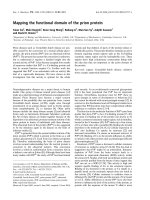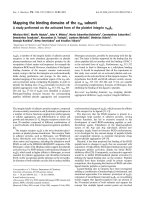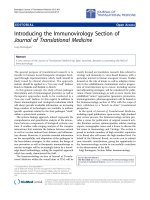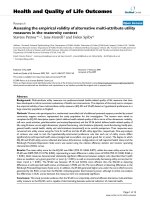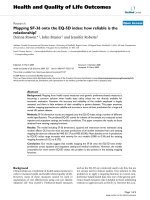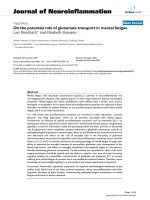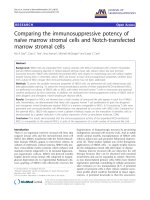Báo cáo hóa học: "Mapping the Polarization Pattern of Plasmon Modes Reveals Nanoparticle Symmetry" pdf
Bạn đang xem bản rút gọn của tài liệu. Xem và tải ngay bản đầy đủ của tài liệu tại đây (151.84 KB, 2 trang )
NANO SPOTLIGHTS
Mapping the Polarization Pattern of Plasmon Modes Reveals
Nanoparticle Symmetry
Published online: 5 September 2008
Ó to the author 2008
Single molecule labeling, cancer treatment, enhancement
of non-linear optical effects, or light guiding have
demanded much attention from the scientific community,
and as a possible solution, plasmon resonances of noble
metal nanoparticles are explored. A major advancement in
single molecule optics has been the polarization analysis of
light from single fluorescent emitters. This analytical
method has been utilized to study the conformational
dynamics of biomolecules and their spatial arrangement. At
different wavelengths of the excitation light, different
oscillation modes are excited making it important to know
the polarization pattern as a function of wavelength.
‘‘Knowing the polarization pattern of plasmonic nano-
structures is therefore not only important to understand the
fundamental physics of light interaction with these struc-
tures, but also allows to discriminate different oscillation
modes within one particle and to distinguish differently
shaped particles within one sample. Several techniques
have been used to extract optical spectra of single plas-
monic nanoparticles, most efficiently using dark-field
microscopy, but little is known about the polarization state.
So far, the very few reported plasmon polarization studies
were obtained by rotating a polarizer by hand or on
ensembles and not combined with spectroscopic informa-
tion,’’ Prof. Carsten Sonnichsen explains to Nano Spotlight.
‘‘We have developed a new microscope setup (RotPOL),
which allows obtaining polarization-dependent scattering
spectra in a fast and easy way,’’ Olaf Schubert continues
explaining to Nano Spotlight. ‘‘RotPOL uses a wedge
shaped quickly rotating polarizer which splits the light of a
point source into a ring in the image plane, encoding the
polarization information in a spatial image.’’ (Scheme 1)
Prof. Sonnichsen’s team reveals that the polarization
intensity in a given direction is simply taken from the
corresponding position on the ring recorded with an
exposure time larger than the rotation time. A dipole, for
example, will show two loops at opposite sides, and with
this in mind, the team can combine this rotating polarizer
with a variable wavelength interference filter, which
transmits light only in a narrow wavelength window. If
mounted in front of the digital camera, the filter allows
them to record simultaneously the spectral and polarization
information for up to 50 particles in parallel.
‘‘With the RotPOL setup, we study plasmon modes of a
large variety of plasmonic structures—from rod-shaped
particles to triangles, cubes, and pairs of spheres,’’ said
Olaf Schubert. ‘‘Each plasmonic particle has a character-
istic ‘footprint’, which allows deducing the approximate
particle shape from the polarization-dependent single-par-
ticle scattering spectra. This is important for the
optimization of particle synthesis, because it makes a quick
and efficient estimation of the quality and mono-dispersal
of a sample possible, without complex and expensive tools
like electron microscopy.’’
‘‘For rod-shaped and even just slightly elongated parti-
cles, we found that the scattered light is highly polarized.
Our simulations show that this high polarization anisotropy
is not only due to the particle symmetry, but a plasmonic
effect. This could be exploited for the design of miniature
rotation sensors,’’ Prof. Sonnichsen explained
enthusiastically.
In addition to yielding orientation information, plas-
monic particles can be used to measure absolute distances
on a nanometer scale. ‘‘Such a ‘plasmonic ruler’ makes use
of the coupling of two spherical particles: If they are close
to each other, the inter-particle plasmon resonance shifts
from green to red. We measured the full polarization-
dependent spectrum of such pairs of two spheres and found
123
Nanoscale Res Lett (2008) 3:348–349
DOI 10.1007/s11671-008-9158-9
nice agreement with simulations.’’ This investigation has
demonstrated that the polarization-dependent spectrum
contains information about both the distances of the two
spheres and the orientation and environment of the parti-
cles. In addition, such ‘‘multi-sensors’’ could possibly find
a place in biological applications that require high time
resolution.
‘‘As an example of a time-resolved measurement, we
have monitored the changes of plasmon modes in single
gold nanoparticles during a growth process, in situ,’’
explains Olaf Schubert to Nano Spotlight. The researchers
highlight that their RotPOL method is a versatile tool that
can be used to study polarization anisotropy of the light
emission pattern from nanoparticles, particularly for plas-
monic structures, but can possibly be extended to
fluorescent quantum structures. This method provides a
wide range for optimization for applications such as light
guiding and allows detailed theoretical modeling of plas-
mon modes due to the wide variety of plasmon emission
patterns observed for the simple particle morphologies that
have been investigated (spheres, rods, triangles, cubes, and
particle pairs).
The researchers have recently published their results in
Nano Lett, 2008. Their work reveals that the high polari-
zation anisotropy found for even moderately elongated
spheres ‘‘highlights’’ the strong influence of polarization
even for nominally round particles. The possibility to
record dynamic changes of the polarization emission pat-
tern of single particles allows studying particle growth
modes in situ and improving schemes for single nanopar-
ticle binding and distancing assays.
Kimberly Annosha Sablon
Scheme 1 (a) Schematics of the RotPOL setup. One wavelength is
selected by a linear variable interference filter (varIF), and then the
light is dispersed into different polarization directions by a wedge-
shaped rotating polarizer (PL), resulting in ring-shaped intensity
profiles of a point-like light source on the digital camera (b). In order
to get the polarization profile shown in (c) (intensity I(q) as a function
of polarization angle q), we integrate the image between an inner and
an outer ring diameter (dashed lines in (b)). The center of the rings is
chosen to minimize asymmetry between opposite sides. Repeating
this procedure for each wavelength produces intensity values as a
function of wavelength and polarization angle I(l,q), which we show
color-coded in (d). The same analysis is possible for all particles
within the field of view in parallel. (e) Real-color image of an
inhomogeneous silver sample containing spheres, rods, and triangles
as seen through the RotPol-microscope. Two colors in one ring
correspond to two different plasmon modes at the respective
wavelengths. Scalebar is 25 lm
Nanoscale Res Lett (2008) 3:348–349 349
123

